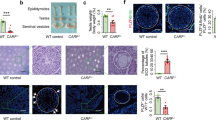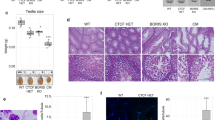Abstract
Spermatogenesis is a multi-step process, regulated by endocrine, paracrine and autocrine signals, through which immature germ cells differentiate into spermatozoa. The cAMP-dependent transcription factor CREM directs in the testis the expression of genes related to the structuring of mature spermatozoa. CREM gene expression originates different isoforms, which in turn can be divided into activators or repressors of gene expression. Whereas only CREM repressors are expressed in pre-meiotic germ cells in mice, a switch to the expression of the CREM activator τ occurs in post-meiotic germ cells. In addition, mice lacking CREM gene are infertile and present an arrest of germ cell maturation at the stage of round spermatid. We have demonstrated that CREM gene is expressed also in human germ cells and that a switch from the expression of repressors to activators is present in normospermic men. In particular, CREM τ mRNA is located in the cytoplasm of round spermatids. Conversely, in patients showing a testicular pattern of round spermatid maturation arrest only CREM repressors are expressed. Other reports have confirmed our data, supporting the hypothesis that CREM plays a role also in human spermatogenesis and that the absence of “the CREM switch” can be associated to spermatogenic arrest.
Similar content being viewed by others
References
Sassone-Corsi P. Transcription factors responsive to cAMP. Annu. Rev. Cell. Dev. Biol. 1995, 11: 355–377.
Walker H.W, Habener J.F. Role of transcription factors CREB and CREM in cAMP-regulated transcription during spermatogenesis. Trends Endocrinol. Metab. 1996, 7: 133–138.
Delmas V., van der Hoorn F., Mellstroem B., Jegou B., Sassone-Corsi P. Induction of CREM activator proteins in spermatids: down-stream targets and implications for haploid germ cell differentiation. Mol. Endocrinol. 1993, 7: 1502–1514.
Kistler M., Sassone-Corsi P., Kistler S.W. Identification of a functional cAMP response element in the 5’-flanking region of the gene for transition protein 1 (TP1), a basic chromosomal protein of mammalian spermatids. Biol. Reprod. 1994, 51: 1322–1329.
Zhou Y., Sun Z., Means A.R., Sassone-Corsi P., Bernstein K.E. cAMP-response element modulator t is a positive regulator of testis angiotensin converting enzyme transcription. Proc. Natl. Acad. Sci. USA 1996, 93: 12262–12266.
Sun Z., Sassone-Corsi P., Means A. Calspermin gene transcription is regulated by two cyclic AMP response elements contained in an alternative promoter in the calmodulin kinase IV gene. Mol. Cell Biol. 1995, 15: 561–571.
Molina C.A., Foulkes N.S., Lalli E., Sassone-Corsi P. Inducibility and negative autoregulation of CREM: an alternative promoter directs the expression of ICER, an early response repressor. Cell 1993, 75: 875–886.
Stehle J.H., Foulkes N.S., Molina C.A., Simonneaux V., Pevet P., Sassone-Corsi P. Adrenergic signals direct rhythmic expression of transcriptional repressor CREM in the pineal gland. Nature 1993, 365: 314–320.
Lamas M., Lalli E., Foulkes N.S., Sassone-Corsi P. Rhythmic transcription and autoregulatory loops: nuclear pace-maker CREM. Cold Spring Harbor Symp. Quant. Biol. 1996, 61: 285–294.
Foulkes N.S., Mellstroem B., Benusiglio E., Sassone-Corsi P. Developmental switch of CREM function during spermatogenesis: from antagonist to activator. Nature 1992, 355: 80–84.
Nantel F., Monaco L., Foulkes N.S., Masquilier D., LeMeur M., Henriksen K., Dierich A., Parvinen M., Sassone-Corsi P. Spermiogenesis deficiency and germ cell apoptosis in CREM-mutant mice. Nature 1996, 380: 159–162.
Blendy J., Kastner K., Weinbauer G., Nieschlag F., Schutz G. Severe impairment of spermatogenesis in mice lacking the CREM gene. Nature 1996, 380: 163–165.
Hummler E., Cole T.J., Blendy J.A., Ganss R., Aguzzi A., Schmid W., Beermann F., Schutz G. Targeted mutation of the CREB gene: compensation within the CREB/ATF family of transcription factors. Proc. Natl. Acad. Sci. USA 1994, 91: 5647–5651.
Foulkes N.S., Schlotter F., Pevet P., Sassone-Corsi P. Pituitary hormone FSH directs the CREM functional switch during spermatogenesis. Nature 1993, 362: 264–267.
Behr R., Weinbauer G.F. Germ-cell specific adenosine 3’-5’-monophosphate response element modulator expression in rodent and primate testis is maintained despite gonadotropin deficiency. Endocrinology 1999, 140: 2746–2754.
Peri A., Krausz C., Cioppi F., Granchi S., Forti G., Francavilla S., Serio M. cAMP-responsive element modulator gene expression in germ cells of normo-and oligoazoospermic men. J. Clin. Endocrinol. Metab. 1998, 83: 3722–3726.
Weinbauer G.F., Behr R., Bergmann M., Nieschlag E. Testicular cAMP responsive element modulator (CREM) protein is expressed in round spermatids but is absent or reduced in men with round spermatid maturation arrest. Mol. Hum. Reprod. 1998, 4: 9–15.
Steger K., Klonisch T., Gavenis K., Behr R., Schaller V., Drabent B., Doenecke D., Nieschlag E., Bergmann M., Weinbauer G.F. Round spermatids show normal testis-specific H1t but reduced cAMP-responsive element modulator and transition protein 1 expression in men with round-spermatid maturation arrest. J. Androl. 1999, 20: 747–754.
Steger K., Klonisch T., Gavenis K., Drabent B., Doenecke D., Bergmann M. Expression of mRNA and protein of nucleoproteins during human spermiogenesis. Mol. Hum. Reprod. 1998, 4: 939–945.
Lin W.W., Lamb D.J., Lipshultz L.I., Kim E.D. Absence of cAMP responsive element modulator expression at the spermatocyte arrest stage. Fertil. Steril. 1998, 69: 533–538.
Print C.G., Loveland K.L. Germ cell suicide: new insights into apoptosis during spermatogenesis. Bioessays 2000, 22: 423–430.
Lin W.W., Lamb D.J., Lipshultz L.I., Kim E.D. The role of autosomal cell apoptosis regulator genes in human spermatogenesis. Int. Urol. Nephrol. 1999, 31: 237–246.
Author information
Authors and Affiliations
Corresponding author
Rights and permissions
About this article
Cite this article
Peri, A., Serio, M. The CREM system in human spermatogenesis. J Endocrinol Invest 23, 578–583 (2000). https://doi.org/10.1007/BF03343779
Published:
Issue Date:
DOI: https://doi.org/10.1007/BF03343779




